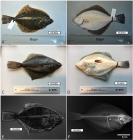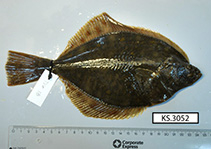WoRMS taxon details
Platichthys solemdali Momigliano, Denys, Jokinen & Merilä, 2018
1264298 (urn:lsid:marinespecies.org:taxname:1264298)
accepted
Species
recent only
Momigliano, P.; Denys, G. P. J.; Jokinen, H.; Merilä, J. (2018). Platichthys solemdali sp. nov. (Actinopterygii, Pleuronectiformes): A New Flounder Species From the Baltic Sea. <em>Frontiers in Marine Science.</em> 5., available online at https://doi.org/10.3389/fmars.2018.00225 [details]
Holotype MZH KS.3052, geounit Gulf of Finland
Holotype MZH KS.3052, geounit Gulf of Finland [details]
Etymology This species is dedicated to Per Solemdal (1941–2016) who was the first researcher to study the Baltic Sea flounder's...
LSID urn:lsid:zoobank.org:act:05645402-62B0-4E96-97B5-8B9D4FD566F7
Etymology This species is dedicated to Per Solemdal (1941–2016) who was the first researcher to study the Baltic Sea flounder's eggs and sperm in connection to salinity and discovered that “the specific gravity of the eggs is a fixed population characteristic which is almost unchangeable” (Solemdal, 1973) laying the foundations on which many subsequent studies on local adaptation and speciation of Baltic Sea marine fishes were built [details]
LSID urn:lsid:zoobank.org:act:05645402-62B0-4E96-97B5-8B9D4FD566F7
LSID urn:lsid:zoobank.org:act:05645402-62B0-4E96-97B5-8B9D4FD566F7 [details]
Froese, R. and D. Pauly. Editors. (2024). FishBase. Platichthys solemdali Momigliano, Denys, Jokinen & Merilä, 2018. Accessed through: World Register of Marine Species at: https://www.marinespecies.org/aphia.php?p=taxdetails&id=1264298 on 2024-05-23
![]() The webpage text is licensed under a Creative Commons Attribution-Noncommercial 4.0 License
The webpage text is licensed under a Creative Commons Attribution-Noncommercial 4.0 License
original description
Momigliano, P.; Denys, G. P. J.; Jokinen, H.; Merilä, J. (2018). Platichthys solemdali sp. nov. (Actinopterygii, Pleuronectiformes): A New Flounder Species From the Baltic Sea. <em>Frontiers in Marine Science.</em> 5., available online at https://doi.org/10.3389/fmars.2018.00225 [details]
basis of record Froese, R. & D. Pauly (Editors). (2023). FishBase. World Wide Web electronic publication. version (02/2023)., available online at https://www.fishbase.org [details]
ecology source Looby, A.; Erbe, C.; Bravo, S.; Cox, K.; Davies, H. L.; Di Iorio, L.; Jézéquel, Y.; Juanes, F.; Martin, C. W.; Mooney, T. A.; Radford, C.; Reynolds, L. K.; Rice, A. N.; Riera, A.; Rountree, R.; Spriel, B.; Stanley, J.; Vela, S.; Parsons, M. J. G. (2023). Global inventory of species categorized by known underwater sonifery. <em>Scientific Data.</em> 10(1). (look up in IMIS), available online at https://doi.org/10.1038/s41597-023-02745-4 [details]
basis of record Froese, R. & D. Pauly (Editors). (2023). FishBase. World Wide Web electronic publication. version (02/2023)., available online at https://www.fishbase.org [details]
ecology source Looby, A.; Erbe, C.; Bravo, S.; Cox, K.; Davies, H. L.; Di Iorio, L.; Jézéquel, Y.; Juanes, F.; Martin, C. W.; Mooney, T. A.; Radford, C.; Reynolds, L. K.; Rice, A. N.; Riera, A.; Rountree, R.; Spriel, B.; Stanley, J.; Vela, S.; Parsons, M. J. G. (2023). Global inventory of species categorized by known underwater sonifery. <em>Scientific Data.</em> 10(1). (look up in IMIS), available online at https://doi.org/10.1038/s41597-023-02745-4 [details]
 Present
Present  Present in aphia/obis/gbif/idigbio
Present in aphia/obis/gbif/idigbio  Inaccurate
Inaccurate  Introduced: alien
Introduced: alien  Containing type locality
Containing type locality
Holotype MZH KS.3052, geounit Gulf of Finland [details]
From editor or global species database
Etymology This species is dedicated to Per Solemdal (1941–2016) who was the first researcher to study the Baltic Sea flounder's eggs and sperm in connection to salinity and discovered that “the specific gravity of the eggs is a fixed population characteristic which is almost unchangeable” (Solemdal, 1973) laying the foundations on which many subsequent studies on local adaptation and speciation of Baltic Sea marine fishes were built [details]Habitat lives in brackish water of varying salinities in the coastal zone at 0.5–50 m depth on soft and hard bottoms. [details]
LSID urn:lsid:zoobank.org:act:05645402-62B0-4E96-97B5-8B9D4FD566F7 [details]
Morphology The specimens belonging to P. solemdali sp. nov. (N = 50) have 46–59 dorsal fin rays (holotype 59), 35–41 anal fin rays (holotype 40), 8–12 pectoral fin rays (holotype 11) on the eye-side and 6 to 11 on the blind side (holotype 10), 5–6 pelvic fin rays (holotype 6) and 16–19 caudal fin rays (holotype 17). Concerning the morphometric data, the body depth measures 43.8–53.5% of the standard length SL (holotype 47.1% SL), the head length 25.7–31.9% SL (holotype 27.6% SL), the dorsal fin base length 76.8–85.6% SL (holotype 80.9% SL), the anal fin base length 50.9–59.4% SL (holotype 55.9% SL), the eye-side pectoral fin length 12.1–15.9% SL (holotype 14.0% SL), the blind side pectoral fin length 10.0–15.5% SL (holotype 12.0% SL), the pelvic fin length 7.7%−11.8% (holotype 9.3% SL), the caudal peduncle length 8.9–13.1% SL (holotype 11.1% SL), the caudal peduncle depth 8.1–11.0% SL (holotype 8.9% SL), the pre-dorsal fin length 5.9–11.4% SL (holotype 7.0% SL), the pre-anal fin length 30.7–45.1% SL (holotype 33.6% SL), the pre-pectoral fin length 24.2–32.7% SL (holotype 28.1% SL), the pre-pelvic fin length 20.0 to 30.0 % SL (holotype 21.0% SL), the snout length 15.8–27.6% of the head length HL (holotype 17.5% HL), the eye diameter 13.8–17.7% HL (holotype 16.1% HL), the interorbital width 0.0–7.4% HL (holotype 6.6% HL) and the post-orbital length 59.2–70.1% HL (holotype 67.6% HL) [details]
| Language | Name | |
|---|---|---|
| English | Baltic flounder | [details] |


